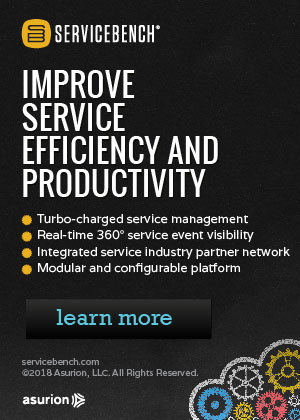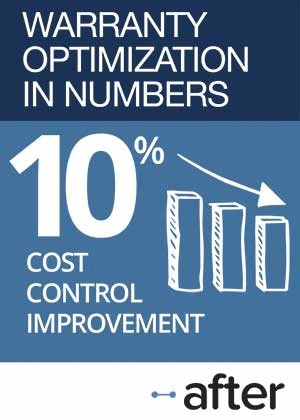Electrical Power Equipment Warranty Report:
While the warranty expenses of most of these manufacturers are generally low, there hasn't been much of an effort to drive them even lower. However, some companies that are seeing costs increase are still cutting the amount they set aside for the future.
As we begin to wind down our tour of the numerous industries whose manufacturers issue product warranties, we get to one where efforts to reduce warranty costs have barely begun. The makers of the equipment that is used to generate electricity are still paying roughly the same share of revenue for warranty work as they were back in 2003, with the exception of some very large companies that also make large vehicles.
We began with a list of 95 companies that were somehow involved in the manufacture of equipment used to generate or store electrical energy. Most were on the generation side of the business, but some 30 were involved in the energy storage business, making everything from batteries for cars to energy storage systems for electrical utilities.
We attempted to include everything from the solar panels and wind turbines that herald the "green" revolution to the meters and towers that mark the traditional industry. The problem -- and we always have a problem with large diversified manufacturers -- is that the three companies at the top of our list are not primarily in this business. They're in other businesses such as trucking and construction, and we suspect that a majority of their warranty expenses comes from those other product lines.
The Big Three of Electricity
So, as we've done with other industries where the leading players are also in other lines of business, in the charts below we've set off on their own the Big Three of electrical power generation equipment: Caterpillar Inc., Cummins Inc., and General Electric Co.
In Figure 1 below, we've added together the total claims paid worldwide per year for these Big Three, plus the other 92 companies on our list. As is plain to see, in each of the past 12 years the Big Three have accounted for well over half the entire industry's total annual claims payments. For instance, in 2014 they represented 68% of the $3.2 billion total.
Figure 1
Worldwide Warranty Claims of
U.S.-based Electrical Power Equipment Makers
(claims paid in US$ millions, 2003-2014)

Over the past 12 years, our Big Three of the electrical power generation equipment business have accounted for about 65% to 70% of the overall warranty expenses of the entire industry. However, we say that knowing that only a minority of the Big Three companies' warranty expenses actually come from this specific industry. Most of their warranty expenses arise from other lines of business such as diesel engines, construction equipment, jet engines, and household appliances.
Caterpillar identifies its Energy & Transportation segment (formerly Power Systems) as the home of its electrical power generation equipment product line. And it identifies both Cummins and GE as among its primary global competitors. The problem is, this business unit also includes diesel-electric locomotives, turbines, reciprocating engines, and compressors. So it's not all electrical power equipment.
Still, the Energy & Transportation segment accounted for $21.7 billion, or about 41% of Caterpillar's total revenue in 2014, against 36% for the Construction Industries segment and only 17% for the mining equipment line of business. So in a way, one could say that while Cat is best-known for its construction equipment, it's really more deeply involved in the power generation business.
Cummins identifies a Power Generation Segment in its product line, focused on standby generators, diesel fuel-based backup power generators, uninterruptible power sources, and distributed generators for use in areas with less reliable electrical power infrastructures, typically in developing countries. It also identifies GE and Caterpillar as competitors, along with Emerson Electric Co. and a handful of foreign or privately-held firms.
But engines for vehicles is definitely the company's main line of business. In 2014, the engine segment accounted for 57% of total revenue, against only 15% for the Power Generation Segment. So it makes more sense to hold Cummins off to the side, because it's likely that a majority of its warranty expenses come from other lines of business besides power generating equipment.
GE is by far the most powerful competitor, if you'll pardon the pun. GE Power & Water is the business segment of interest, with a product line that includes traditional gas-powered electrical generation plants and nuclear reactors built for utilities, wind turbines, and distributed generators.
GE Power & Water accounted for 19% of GE's total revenue in 2014, against 16% for GE Aviation and only 6% for GE Appliances. Behind GE Capital, it was the largest business unit within the whole company. And within that $27.6 billion slice, the wind turbines accounted for about $6.3 billion, while the traditional utility products and services accounted for a combined $14.3 billion.
Segmenting Warranty Costs Like Revenue?
So let's assume for a moment that warranty expense arises across each company's product line at the same rate as revenue (it doesn't work that way, but let's suspend our doubts). In other words, let's assume that 41% of Cat's warranty expense is from power generation equipment, along with 15% for Cummins and 19% for GE. That would cut the Big Three's total warranty expense in this industry by more than two-thirds, and would result in their share of the total dropping from the 65% to 70% range to more like 35% to 40%.
Therefore, it makes sense to hold them off to the side. More than half their warranty expenses don't belong here. Something like 60% to 65% of their total claims and accruals belong to another industry such as aviation, construction, or trucking. Electrical power generating equipment is important to all three, but for none of them is it their largest line of business.
Still, we're stuck with one set of numbers from each company for all their warranty costs worldwide. It would be nice if they segmented their warranty expenses the same way that they do with their revenue. But they don't. And it's foolish to assume that warranty expenses arise at the same rate from mining equipment, diesel engines, and refrigerators. If anything, the past dozen newsletters have proven how different each industry is from all the others.
Among the Big Three, GE cut its claims cost by a whopping $100 million last year, while Cat saw its claims cost rise by $133 million and Cummins saw its claims cost fall by $23 million. On balance, then, there was little change within the Big Three, though there were big changes within the group.
Among the rest of the pack, there was a slight decrease in claims paid in 2014, and 2013 was also a little below 2012's total. But annual claims payments have remained rather steady since 2008, as is obvious in Figure 1. The big surprise is that the industry peak came in 2012, rather than just before the recession kicked in.
The big changes were further down the list. First Solar Inc. cut its claims payments in half, from $33.5 million in 2013 to $16.7 million in 2014. Woodward Inc. cut its claims by about a third, from $14.4 million to $9.7 million. And Itron Inc., which is technically in the electrical meter manufacturing business rather than the electrical generation business, cut its annual claims cost from $23.6 million to $16.6 million.
And then there were a bunch of companies that paid out more in 2014 than they did in 2013. Franklin Electric Co. Inc. led the pack, with a jump in claims payments from $8.1 million in 2013 to $20 million in 2014. It was followed by SunPower Corp., which more than doubled its claims payments from $19 million to $40 million. And Tesla Motors Inc., thanks to some impressive sales gains, paid out $14 million last year, up from $9 million in 2013.
Warranty Accruals
Warranty accruals are more closely tied to both product sales and changes in reliability and repair cost than claims are. But a company that sees a big jump in claims has to be careful to decide whether such an increase is a transient event or the beginning of a trend.
That's why some of these annual changes are such a surprise. For instance, we just got through telling you that SunPower's claims more than doubled last year. Yet the company cut its accruals from $40 million in 2013 to $25 million in 2014. Such a contradiction requires a high level of boldness, though few companies do much to advertise the discrepancy. Instead, they simply list the numbers in a table and say not a word about why.
Others that reduced their accruals significantly in 2014 included Babcock & Wilcox Co.; Dresser-Rand Group Inc.; Flowserve Corp.; Generac Holdings Inc.; Roper Industries Inc.; and again, Woodward Inc. But three of these six also reduced claims payments, one kept claims essentially the same, and only Generac and Roper saw small increases in claims payments last year. In other words, no big contradictions.
At the other extreme, five companies saw big increases in accruals: Ametek Inc.; Briggs & Stratton Corp.; Carlisle Companies Inc.; Hubbell Inc.; and again, Tesla Motors. But this time, all five also saw rising claims payments, and as in the case of Tesla, also big sales gains driving the need for more accruals.
Figure 2
Worldwide Warranty Accruals of
U.S.-based Electrical Power Equipment Makers
(claims paid in US$ millions, 2003-2014)

Overall, the annual total for all 95 companies grew from $3.14 billion in 2013 to $3.26 billion in 2014. Cat increased its accruals dramatically, by more than $300 million, while GE cut its accruals by $152 million and Cummins cut its accruals by $20 million. Without the Big Three, the other 92 companies in this industry cut their accruals by about $10 million last year. And by the way, the peak year was even later than it was with claims.
In general, what we've found as we wrap up our tour of the 16 different industry categories of manufacturers that issue warranties, is that the recession hit hard for consumer-facing products such as cars and homes, and hit hardest at hybrids such as car-homes, better known as recreational vehicles. but the recession wasn't as deep or impactful in the purely business-to-business and infrastructure-oriented industries, such as the one we're doing this week (though there is a growing residential solar energy market mixed in here as well).
For instance, look at the peaks in accruals in Figure 2. For both GE and Cat, 2008 were the biggest years in terms of setting aside funds for warranty expenses. And their second-biggest years were just three years later. GE has a presence in household appliances (which it's selling), but we can't think of a single consumer product made by Caterpillar (besides perhaps the gifts and apparel sold by the Cat Merchandise Center).
The point is, with both claims and accruals, this cohort has remained about the same since 2008 in terms of dollars apportioned per year. And compared to automotive, appliances, or homebuilding, there's no evidence of either a recession or a recovery in the warranty data.
Warranty Reserves
The amount of warranty reserves held by the 95 companies engaged in the manufacture of electrical power generating equipment also hasn't changed much. In fact, the industry total has been very close to $5.5 billion for four years in a row, with the 2011-ending balance slightly in the lead.
Figure 3
Worldwide Warranty Reserves of
U.S.-based Electrical Power Equipment Makers
(claims paid in US$ millions, 2003-2014)

Once again, the generally unchanged overall industry total conceals some big changes at individual companies. Cummins raised its reserves by $154 million while GE cut its reserves by $125 million. Proportionally, though, the biggest change in reserves was Tesla's increase from a $53 million balance at the end of 2013 to $129 million at the end of 2014.
Also, Hubbell more than doubled its reserves balance, from $6.6 million in 2013 to $13.7 million in 2014. At the other extreme, Roper Industries took out $5 million; Itron took out $9 million; and Terex Corp., which manufactures primarily cranes and material handling equipment but also has a line of business aimed specifically at electrical utilities, let its reserves balance decline by $20 million last year.
Warranty Expense Rates
Overall, manufactured product revenue was up by about 3.7% for the entire list of 95 companies last year, which is important because it closely matches the 3.8% increase in warranty accruals and is not far off from the 2.3% gain in warranty reserves. One would expect them to grow proportionally, and indeed this is what happened last year.
Over the past decade, in fact, warranty expenses and sales have more or less remained in proportion to one another, as can be seen in Figure 4 below. To generate this chart, we took the claims and accrual totals from Figures 1 and 2 and divided them by manufactured product sales figures (no finance or service revenue).
Figure 4 excludes the sales revenue of Caterpillar, GE and Cummins, which has two effects. First, it lowers the average expense rate to roughly 0.8%, plus or minus 0.2% over the past 12 years. Second, it removes any sense of an upward or downward trend from the data -- it just remains within that range of 0.6% to 1.0% except for one data point out of 96.
Figure 4
All Electrical Power Equipment Manufacturers
Except Caterpillar, GE & Cummins
Average Warranty Claims & Accrual Rates
(as a % of sales revenue, 2003-2014)

But again, the stability of the industry averages conceals some big movements among the individual companies. For instance, First Solar kept its accrual rate about the same despite seeing its claims rate fall from 1.0% to 0.5% in the past year. Itron kept its accrual rate about the same despite seeing its claims rate fall from 1.2% to 0.8% over the same time period. SPX Corp., Hubbell, and Carlisle increased their accrual rates despite seeing a decline in their claims rates. Regal-Beloit and Ametek raised their accrual rates despite having relatively unchanged claims rates.
At the other extreme, SunPower cut its accrual rate almost in half, from 1.7% to0.9%, despite seeing its claims rate double, from 0.3% to 0.7%. We noted above how it cut accruals as claims rose. Here, we're confirming that it wasn't just because sales have been growing fast as well. What we're saying is that warranty expenses have been rising and falling faster than sales.
Tesla Raises Accruals
Meanwhile, Tesla has seen product sales rise by 60%, from $2.0 billion in 2013 to $3.2 billion in 2014. So it's no shock to see claims rise proportionally, from $61 million to $97 million. What's shocking is to see accruals rise much faster, from $53 million to $129 million. That suggests the company is getting ready for a hefty increase in the amount of warranty work needed per vehicle on its electric cars.
The automotive industry, as we detailed in the April 9 newsletter, is more accustomed to paying out between 2.0% and 3.0% of its revenue in warranty claims. So Tesla's 1.0% to 1.2% is below average for that industry. But it's above average for this industry. But we saw the same thing last week with sports equipment warranties: when you put wheels on it, warranty costs rise.
Meanwhile, in Figure 5, we've charted the average warranty expense rates of just Caterpillar, General Electric, and Cummins. Compared to Figure 4, these companies are spending a much higher percentage of their revenue on warranty costs. So that's another reason to keep them separated: they not only spend more money on warranties, but they also spend a larger percentage of their total revenue on warranties.
Figure 5
Caterpillar, GE & Cummins
Average Warranty Claims & Accrual Rates
(as a % of sales revenue, 2003-2014)

There is one encouraging trend in the data points of Figure 5, however. Except for the recessionary spike in the claims rate seen in 2009, the 12-year trend has been decidedly downwards. Back at the beginning of 2003, both their average claims and accrual rates were just north of two percent. By the end of 2014, both rates were just south 0f 1.2%.
So while it's accurate to say that not much has changed in the wider electrical power generating equipment market in terms of warranty costs, for these three diversified manufacturers at least the story also includes some warranty cost-cutting. Their claims and accrual totals haven't changed much in dollar terms, but sales have grown, so the expense rates have fallen over time.









